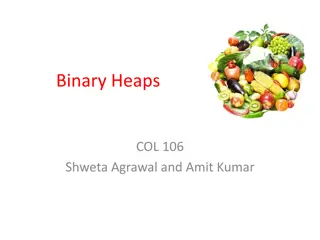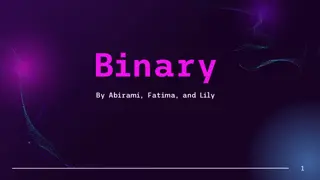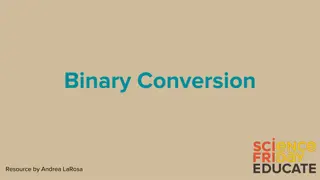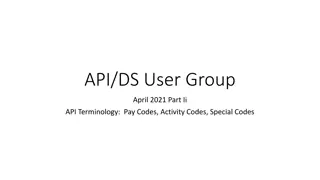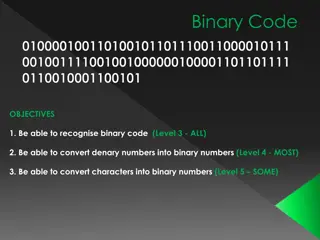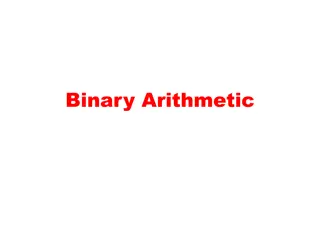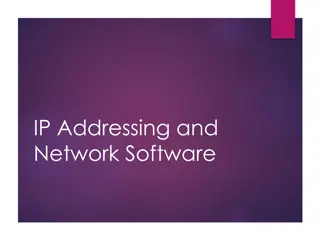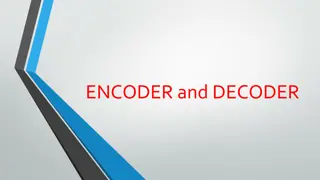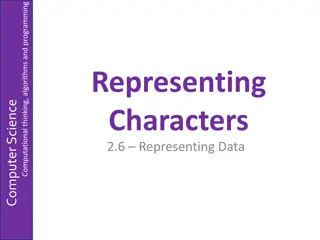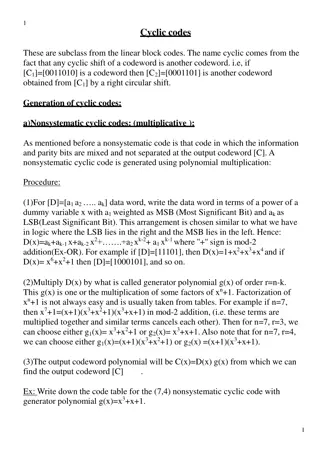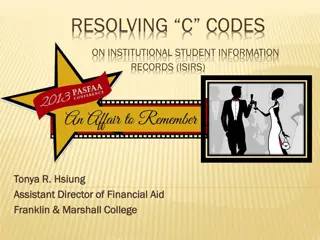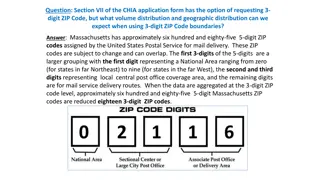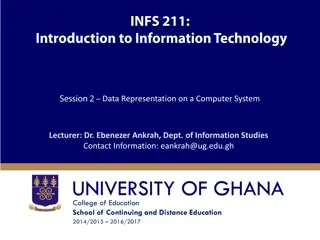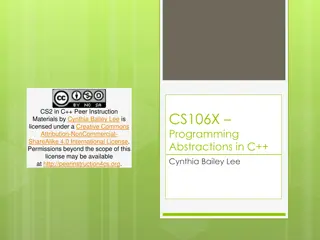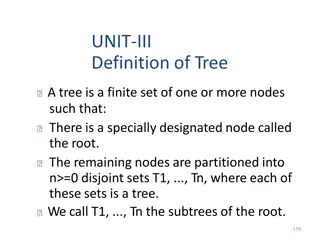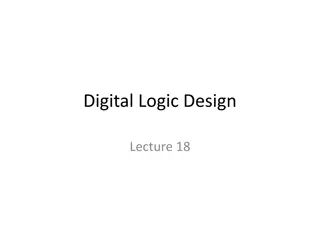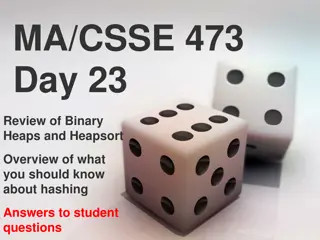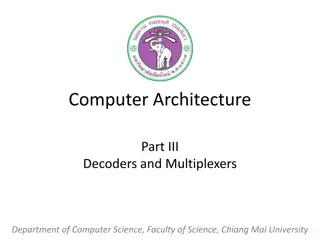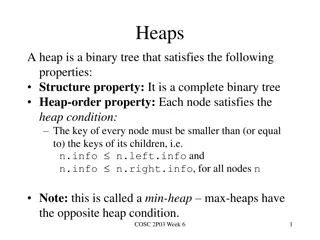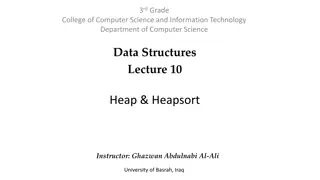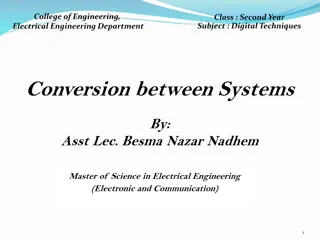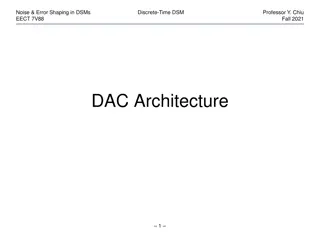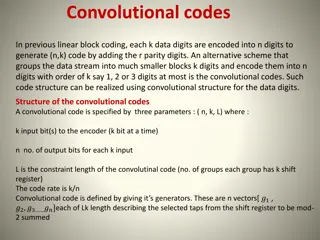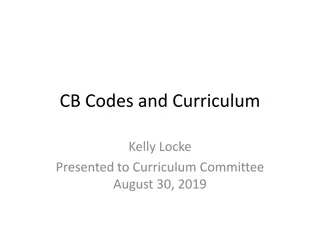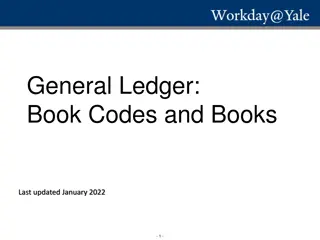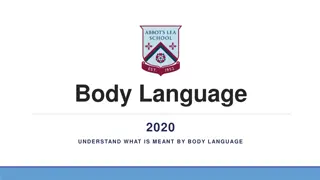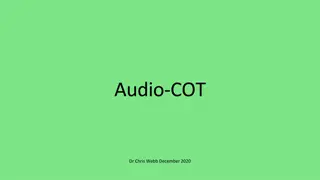Understanding Binary Codes and Self-Complementing Codes
The concept of binary codes, including Binary Coded Decimal (BCD) codes, and self-complementing codes is explored in this informative content. Learn about how decimal numbers are represented in binary form, the structure of BCD codes, and the properties of self-complementing codes like 2421 and Excess-3. Understanding these coding systems is essential for effective interaction between humans and computers.
Download Presentation

Please find below an Image/Link to download the presentation.
The content on the website is provided AS IS for your information and personal use only. It may not be sold, licensed, or shared on other websites without obtaining consent from the author. Download presentation by click this link. If you encounter any issues during the download, it is possible that the publisher has removed the file from their server.
E N D
Presentation Transcript
BINARY CODES Dr.S.Vaaheedha Kfatheen Assistant Professor Department of Computer Science & Jamal Mohamed College (A) Trichy- 620 020. IT
INTRODUCTION - Even though the binary number system has many practical advantages and is widely used in digital computers. - In many cases it is convenient to work with decimal number system. - For better interaction between man and computer, it will be good if the computers read input data in decimal form and print or display output in decimal form. 3
- To facilitate this interaction, many binary codes have been developed. - By means of these codes, decimal digits are represented by sequences of binary digits. - A simple form of one such code is binary coded decimal codes, or simply BCD codes. 4
1. BCD CODES - A group of bits which are used to represent decimal numbers 0 to 9 are called to Binary Coded Decimal codes or BCD codes. - The 8421 indicates the binary weights of 4-bits (23, 22,21,20) for numbers 0-9 . - Any number greater than 9 can be represented in 8421 BCD, by repeatedly using the 4-bit code for each digit. 5
S.NO DECIMAL NUMBER BCD 1 0 0000 2 1 0001 3 2 0010 4 3 0011 5 4 0100 6 5 0101 7 6 0110 8 7 0111 9 8 1000 10 9 1001 For numbers > 9 11 26 0010 0110 12 13 0001 0011 13 74 0111 0100 6 14 56 0101 0110
2. SELF COMPLEMENTING CODES - If a binary code representing a decimal digit D is constructed such that when we complement each bit, we obtain the code for (9-D), it is called a self complementing code. - That is in a self complementing code the 1s complement of the BCD must be equal to the BCD of the 9s complement of the decimal. 7
- For example 84-2-1, 2421 and 4221 codes are self complementing weighted codes. - A necessary condition for a weighted code to have self complementing property is that the sum of the weights used must be equal to 9 - (8+4-2-1 = 9 and 2+4+2+1=9). - But a self complementing code need not necessarily be a weighted code. - An important, unweighted self complementing code is the Excess-3 code. 8
DECIMAL 2421 4221 0 0000 0000 1 0001 0001 2 0010 0010 3 0011 0011 4 0100 0110 5 1011 1001 6 1100 1100 7 1101 1101 8 1110 1110 9 1111 1111 9
- 2421 CODE: Example - Binary code for 4 = 0100 - 9 s complement of 4 = 1011 = 5 The 1 s complement of 4 is 5 which is 1 s complement of 4. 4221 CODE: Example - Binary code for 4 = 0110 - 1 s complement of 4 = 1001 = 5 - The 1 s complement of 4 is 5 which is the 9 s complement of 4. - The 2421 and 4221 codes are also called as weighted codes 10
Rs2s R-1 s Binary code of a decimal number is complemented, the binary code representing the 9 s complement of the decimal number. 4- decimal = 0100 (2421) 1 s complement 1011 Decimal - 5 11
6-i/p 0110 Decimal 2421 binary Binary 1 s (0110=1001) 1 s decimal 3 o/p 9-6=3 12
0110 1001 1 s 5 9-5=4 9 s 13
EXCESS 3 CODE - The Excess-s code is another BCD code. - The Excess-s code for a decimal digit is obtained by adding 0011(3) to the 8421 code. - It has 10 valid codes and 6 invalid codes. - The 6 invalid codes are - 0000 1101 - 0001 1110 - 0010 1111 14
8 4 2 1 (5) 0 1 0 1 - 8421 (binary code) 1 1 + 1 0 0 0 - Excess-3(binary code) 15
In Excess-3 if any number is greater than 9 then the code is given separately for each digit. Excess-3 is not a weighted code. Excess-3 is a self-complementing code 16
S.NO DECIMAL NUMBER 8421 Excess-3 1 0 0000+0011 0011 2 1 0001 0100 3 2 0010 0101 4 3 0011 0110 5 4 0100 0111 6 5 0101+0011 1000 7 6 0110 1001 8 7 0111 1010 9 8 1000 1011 10 9 1001 1100 For numbers > 9 10 26 0010 0110+0011 0101 1001 11 97 1001 0101 1100 1010 12 853 1000 0101 0011 1011 1000 0110 17
GRAY CODES - Gray code is an unweighted code in which successive numbers differ in only one bit position. - Such codes are used in analog to digital conversion. - The Gray code is a standard binary code, and not a weighted code. - The Gray code of a decimal number can be obtained by converting binary number using specific procedures. 18
- Gray code is not convenient for arithmetic operation. - Such a code in which not more than one bit differs from its neighbours is called Gray code or cyclic code or reflected code. - This concept is formalized by defining what is known as hamming distance. - The hamming distance between two binary codes of equal length is the number of bit positions in which they differ. 19
- For example, if A=0110 and B=1010 the hamming distance between A and B is two, since they differ in two bit position. - Hamming distance between two successive code groups in a cyclic code is unity. 20
- Rules for converting binary to gray - 1. The MSB of the gray code is the same as the MSB of the binary - 2. Coding from left to right, add each adjacent pair of bits to get the next bit of the gray code. - Omit the carries, if occurs. 21
The following formulae define binary to gray conversion Let B = BnBn-1Bn-2 B0 represent a natural binary number Let G = GnGn-1Gn-2 .G0 represent equivalent gray code Then Gn = Bn Gn-1 = Bn + Bn-1 22
- Eg., - Convert the binary number 1011 to gray code. - Step1: 1 0 1 1 - 1 1 1 1 - Step2: 1 + 0 1 1 - 1 1 1 1 1 0 - (1011)2 = (1110)G Step3: 1 0 + 1 1 Step4: 1 0 1 + 1 23
Example: Binary Gray 1101 1011 1110 1001 1001 0111 1101 0100 24
Rules for converting Gray to Binary 1. The MSB of the binary is the same as the MSB of the Gray 2. Coding from left to right add the binary digit generated to the adjacent gray bit to get the next bit of the binary 3. Omit the carries, if occurs. 25
The following formulae define binary to gray conversion Let G = GnGn-1Gn-2 .G0 represent a Gray code Let B = BnBn-1Bn-2 B0 represent a equivalent Binary code Then Bn = Gn Bn-1 = Bn + Gn-1 26
Convert the Gray code 1110 to Binary Step1: 1 1 1 0 1 + Step2: 1 1 1 0 1 0 1 + 1 0 + 1 0 1 1 Step3: 1 1 1 0 Step4: 1 1 1 0 27
Example Gray Binary 0111 0101 0100 0111 1101 1001 1110 1011 28
ALPHANUMERIC CODES 1. ASCII Code - ASCII is an alphanumeric code which stands for American Standard Code for Information Interchange. - ASCII is a 7-bit code that is used to represent decimal digits 0 to 9, alphabets A to Z both cases and some special characters - In ASCII, there are 27 = 128 possible binary combinations 29
- ASCII also includes some control characters like DEL, ESC, STX(START of Text), ETX (End of Text) etc. 30
ASCII Symbol Decimal Hexa 7-Binary 0 48 30 011 0000 1 49 31 011 0001 2 50 32 011 0010 9 57 39 011 1001 . . . . A 65 41 100 0001 B 66 42 100 0010 a 97 61 110 0001 b 98 62 110 0010 DEL 127 7F 111 1111 31
2. EBCDIC - EBCDIC stands for Extended Binary Coded Decimal Interchange Code. - Another alphanumeric codes used in IBM machine is the EBCDIC - It uses 8-bit for each character and a ninth bit for parity. - It has the same character symbols as ASCII but the bit assignment to character is different. 32
References 1. Albert Paul Malvino, Donald P. Leach and Goutam Saha, Digital Principles and Applications, TMH, 2.Morris Mano M, Computer System Architecture, PHI, Third Edition, 2008 Sixth Edition, 2007. 33


